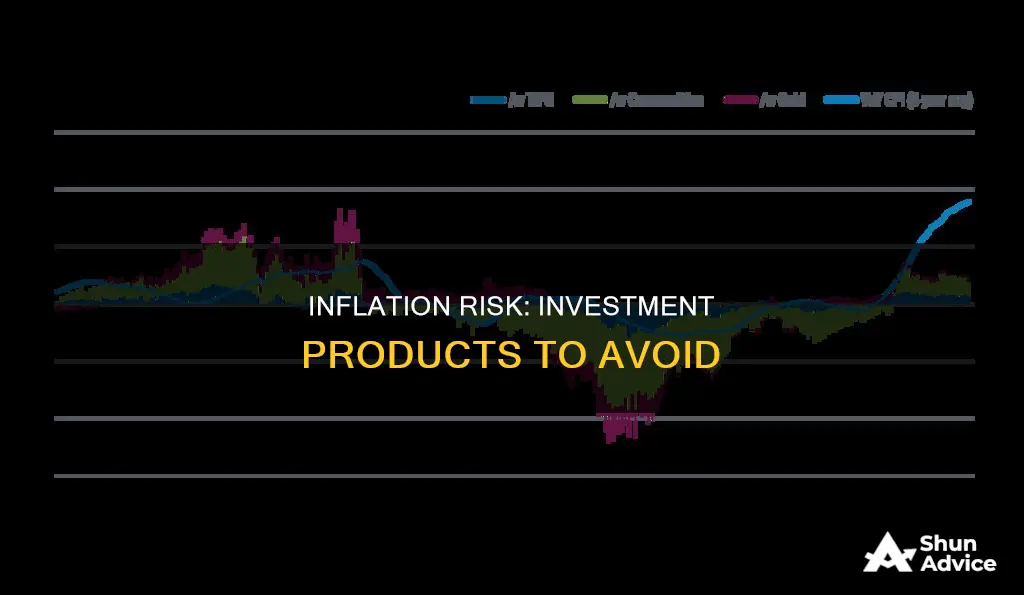
Inflation risk is the chance that the future value of an investment will be reduced by unanticipated inflation. Bonds are considered the most vulnerable to inflationary risk, as their payouts are generally based on fixed interest rates, meaning an increase in inflation diminishes their purchasing power. Other investments that are prone to inflation risk include certificates of deposit, money accounts, and other less liquid cash investments.
| Characteristics | Values |
|---|---|
| Most vulnerable investment product | Bonds |
| Reason | Fixed coupon rate that doesn't increase |
| Other vulnerable investment products | Certificates of deposit, money accounts, other less liquid cash investments |
| Assets that can protect against inflation | UK index-linked gilts, US treasury inflation-protected securities (TIPS), real estate investment trusts (REITs), exchanged traded funds (ETFs) on REITs, physical real estate holdings, commodities and commodity exchange traded products (ETPs), gold |
What You'll Learn

Bonds
Treasury inflation-protected securities (TIPS) are one way to address inflationary risk. They adjust their coupon and principal payments according to changes in the consumer price index (CPI), thereby giving the investor a guaranteed real return based on the actual inflation rate. Inflation-linked gilts (also called inflation-indexed bonds) are another option. These are securities whose value is linked to inflation rates, meaning that they may provide a hedge against inflation.
However, it's important to note that even with these securities, unexpected inflation can still occur, which can be difficult to adjust for. This is because simply building an inflation premium into a required interest rate or RoR when making an investment cannot adjust for unanticipated inflation.
To protect against inflation, investors can also consider commodities, such as precious metals or agricultural products, as their prices tend to rise during periods of inflationary pressure. Additionally, investing in startups with pricing power – the ability to increase prices to offset the impact of inflation on costs – may be a good strategy.
Float Costs: Understanding Their Impact on Investment Risk
You may want to see also

Commodities
Another way to invest in commodities is through commodity-linked notes (CLNs). These are structured products that are linked to the performance of a specific commodity or a basket of commodities. CLNs typically have a fixed maturity date and offer investors a return that is based on the change in the price of the underlying commodity or commodities.
Finally, investors can also consider investing in companies that are exposed to commodities, such as mining companies or agricultural producers. These companies can benefit from rising commodity prices, which can boost their profits and, in turn, their stock prices.
Investing in Employees: What Do Employers Spend On?
You may want to see also

Certificates of deposit
Bonds are considered the most vulnerable to inflationary risk. However, other investment products are also prone to inflation risk, including certificates of deposit.
CD rates tend to track the Consumer Price Index (CPI), which should alleviate concerns over inflation risk. However, a closer examination of how inflation is measured may be a cause for concern if you are worried about your actual purchasing power in the future. Inflation-protected CDs help guard investors against the risk of inflation by indexing their deposits against the CPI and paying out additional funds in the event of rising prices. This is in contrast to regular CDs, whose accruals don't reflect CPI.
In a high-inflation environment, inflation poses a particular threat to fixed-rate investments like CDs. There are alternative investment options that are less prone to inflation risk, such as Series I savings bonds, which are just as safe as CDs.
Emerging Growth Equities: A Guide to Smart Investing
You may want to see also

Gold
Bonds are considered the most vulnerable to inflationary risk. This is because most bonds receive a fixed coupon rate that doesn't increase, so if an investor buys a 30-year bond that pays a four per cent interest rate, but inflation skyrockets to 12 per cent, the investor is in serious trouble.
Other assets that can be looked to for protection against inflation include UK index-linked gilts and US treasury inflation-protected securities (TIPS), real estate investment trusts (REITs), exchanged traded funds (ETFs) on REITs, physical real estate holdings, and commodity exchange traded products (ETPs).
Mastering Risky Investments: Strategies for Success
You may want to see also

Inflation-linked gilts
Bonds are considered the most vulnerable to inflationary risk. This is because bond payments are generally based on fixed interest rates, meaning that an increase in inflation diminishes their purchasing power.
Overall, inflation-linked gilts can be a valuable tool for investors looking to mitigate the effects of inflation on their portfolios. By linking their value to inflation rates, these gilts can provide a hedge against inflation and help to preserve the purchasing power of an investment.
Collectibles and Metals: Low-Risk, High-Value Investments?
You may want to see also
Frequently asked questions
Bonds are considered the most vulnerable to inflationary risk. This is because bond payments are generally based on fixed interest rates, meaning an increase in inflation diminishes their purchasing power.
Inflationary risk is the risk that the future real value (after inflation) of an investment, asset, or income stream will be reduced by unanticipated inflation.
There are several assets that can be looked to for protection against inflation, including: index-linked gilts, treasury inflation-protected securities (TIPS), real estate investment trusts (REITs), exchanged traded funds (ETFs), physical real estate holdings, commodities and commodity exchange traded products (ETPs).
Commodities such as precious metals or agricultural products may help protect against inflation as their prices tend to rise during periods of inflationary pressures.







